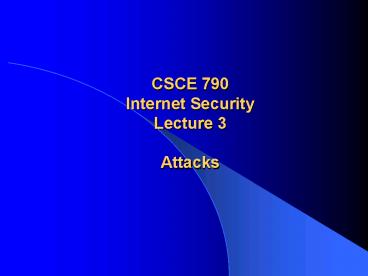CSCE 790 Internet Security Lecture 3 Attacks - PowerPoint PPT Presentation
1 / 33
Title:
CSCE 790 Internet Security Lecture 3 Attacks
Description:
Network interface: 'promiscuous mode' able to capture all frames transmitted ... cmp SunOS 4.x: detects promiscuous mode. AntiSniff (L0pht Heavy Industries, Inc. ... – PowerPoint PPT presentation
Number of Views:43
Avg rating:3.0/5.0
Title: CSCE 790 Internet Security Lecture 3 Attacks
1
CSCE 790Internet SecurityLecture 3Attacks
2
Reading Assignment
- Reading assignments for January 22
- Required
- Oppliger Ch 3. Attacks
- Recommended
- Maximum Security Ch. 15 Sniffers
- Reading assignments for January 24
- Required
- Oppliger Ch 5. Cryptographic Tecniques
- 5.1, 5.2, 5.3
3
Attack
- RFC 2828
- An assault on system security that derives from
an intelligent threat, i.e., an intelligent act
that is a deliberate attempt (especially in the
sense of a method or technique) to evade security
services and violate the security policy of the
system.
4
Normal Flow
Information source
Information destination
5
Interruption
Information source
Information destination
Asset is destroyed of becomes unavailable -
Availability Example destruction of hardware,
cutting communication line, disabling file
management system, etc.
6
Interception
Information source
Information destination
Unauthorized party gains access to the asset
Confidentiality Example wiretapping,
unauthorized copying of files
7
Modification
Information source
Information destination
Unauthorized party tampers with the asset
Integrity Example changing values of data,
altering programs, modify content of a message,
etc.
8
Fabrication
Information source
Information destination
Unauthorized party insets counterfeit object into
the system Authenticity Example insertion of
offending messages, addition of records to a
file, etc.
9
Passive Attack
- Attempts to learn or make use of information
from the system but does not affect system
resources (RFC 2828)
Sniffer
10
Sniffers
- All machines on a network can hear ongoing
traffic - A machine will respond only to data addressed
specifically to it - Network interface promiscuous mode able to
capture all frames transmitted on the local area
network segment
11
Risks of Sniffers
- Serious security threat
- Capture confidential information
- Authentication information
- Private data
- Capture network traffic information
12
Passive attacks
Interception (confidentiality)
Release of message contents Traffic analysis
13
Release of message content
- Intruder is able to interpret and extract
information being transmitted - Highest riskauthentication information
- Can be used to compromise additional system
resources
14
Traffic Analysis
- Intruder is not able to interpret and extract the
transmitted information - Intruder is able to derive (infer) information
from the traffic characteristics
15
Protection against passive attacks
- Shield confidential data from sniffers
cryptography - Disturb traffic pattern NRL
- Traffic padding
- Onion routing
- Modern switch technology network traffic is
directed to the destination interfaces - Detect and eliminate sniffers
16
Detection of sniffer tools
- Difficult to detect passive programs
- Tools
- Snifftest SunOS and Solaris can detect
sniffers even if the network interface is not in
promiscuous mode - Nitwitt Network Interface Tap can detect
sniffers even if the network interface is not in
promiscuous mode - Promisc Linux
- cmp SunOS 4.x detects promiscuous mode
- AntiSniff (L0pht Heavy Industries, Inc. )
remotely detects computers that are packet
sniffing, regardless of the OS
17
Active attacks
- Attempts to alter system resources of affect
their operation (RFC 2828)
18
Active attacks
Interruption Modification Fabrication (availabil
ity) (integrity) (integrity)
19
Active Attacks
- Masquerade
- Replay
- Modification of messages
- Denial of service
- Degradation of service
- Spoofing attacks
- Session hijacking
20
Masquerade
- One entity pretends to be a different entity
- Usually involves additional attacks, e.g.,
- Authentication sequences captured and replay
21
Replay
- Passive capture of data unit and its
retransmission
22
Modification of messages
- Some portion of the legitimate message is altered
or - Message is delayed or reordered
23
Denial of service
- Prevents of inhibits the normal use or management
of resources - May range from blocking a particular resource or
the entire network - Past attacks aim to crash systems of a victim
24
DoS attacks
- E-mail bombing attack floods victims mail with
large bogus messages - Popular
- Free tools available
- Smurf attack
- Attacker multicast or broadcast an Internet
Control Message Protocol (ICMP) with spoofed IP
address of the victim system - Each receiving system sends a respond to the
victim - Victims system is flooded
25
DoS attacks
- TCP SYN flooding
Server
Client (initiator)
Half-open connection server is waiting
for clients ACK
26
TCP SYN flooding
- Server limited number of allowed half-open
connections - Backlog queue
- Existing half-open connections
- Full no new connections can be established
- Time-out, reset
27
TCP SYN flooding
- Attack
- Attacker send SYN requests to server with IP
source that unable to response to SYN-ACK - Servers backlog queue filled
- No new connections can be established
- Keep sending SYN requests
- Does not affect
- Existing or open incoming connections
- Outgoing connections
28
Distributed denial of service (DDoS)
- Use additional systems (zombies) on the
Internet to lounge a coordinated attack
29
Protection against DoS, DDoS
- Hard to provide full protection
- Some of the attacks can be prevented
- Filter out incoming traffic with local IP address
as source - Avoid established state until confirmation of
clients identity - Internet trace back determine the source of an
attack
30
Degradation of Service
- Do not completely block service just reduce the
quality of service
31
Spoofing attacks
- IP spoofing
- DNS spoofing
- Sequence number guessing
32
Sequence number guessing
- Weaknesses
- TCP/IP host does not verify the authenticity of
the source IP - x,y are not randomly generated gt attacker may
guess value of y with good accuracy
Server
Client (initiator)
33
Sequence number guessing
C
3. ACK(Y)
1. SYN(X) ID(B)
B
2. SYN(Y), ACK(X)
A































